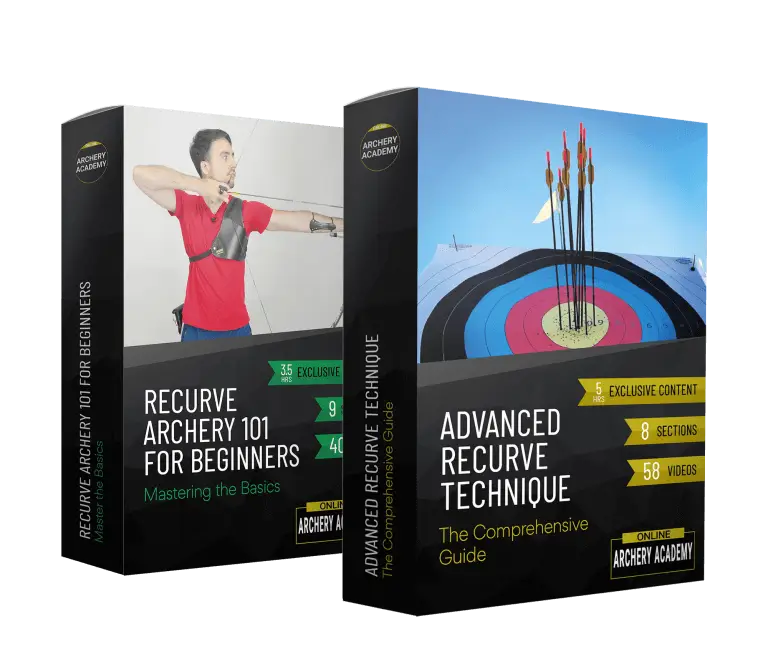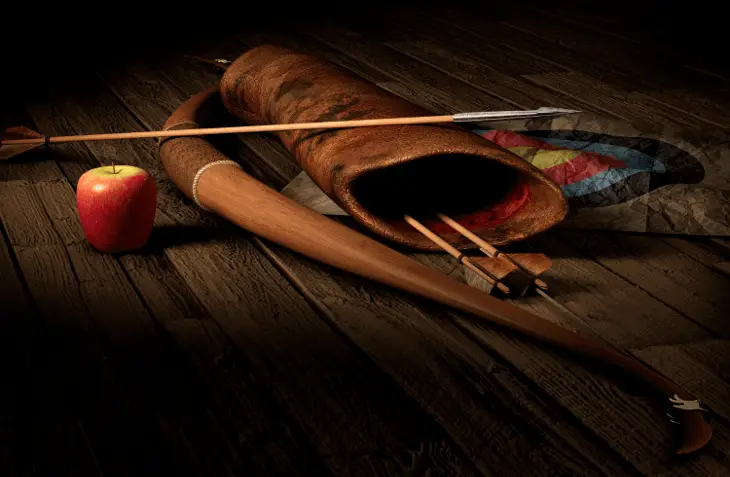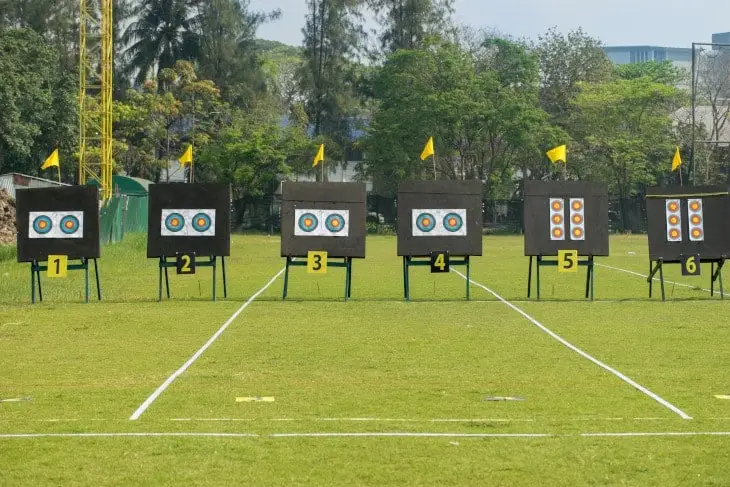Most new archers seem to understand the basics about bows—the different types of bows, the parts, the accessories you can add on—but a LOT of new archers are totally baffled when it comes to arrows.
And there’s a reason for that—arrows are wildly confusing! They’re totally perplexing to select, and there’s not a lot of clear information on the internet about how to choose arrows. They’re especially difficult when you’re starting out, and trying to figure out what type of gear you’ll need.
This is a long, long post, but by the end of it, you’ll have a very clear understanding of how to select arrows. We’ll start with some very basic information, and gradually introduce more complicated topics, and by the time we wrap up, you’ll have a clear understanding of how to find arrows that are right for your bow.
And, if you’re looking for arrow recommendations, you can jump to the section titled “Arrows We Like” below 🙂
Let’s jump in:
Parts of an Arrow
First things first: the actual parts of an arrow. You’ve got:
- The Shaft: This is the length of the arrow, and they’re made from different types of materials—usually wood, aluminum, carbon, or an aluminum-carbon mix—and each material behaves differently and is used for different purposes (more on that below);
- The Arrow Head (aka “Points”): This is the sharp point at the end of the arrow. There are different types, which we describe below;
- The Fletching: These are the three vanes at the back of the arrow, and they’re usually made of feathers or plastic. Very often, two of the vanes are one color, and the third vane is a different color; the vane of a different color is called the “index vane”; and finally
- The Nock: This is the slotted tip at the back end of the arrow. It’s usually plastic, and it fits snugly on the bow string, at a strategic place called the “nocking point.”
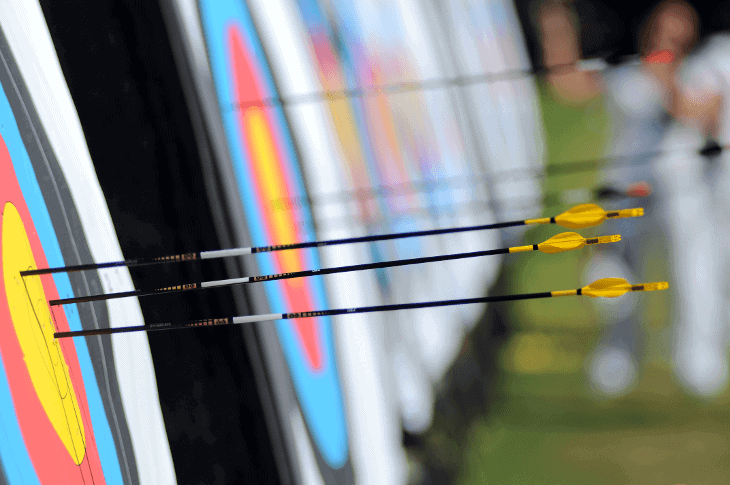
We mentioned above that there are different styles of arrow heads, and each one serves a different purpose:
- Bullet points are moderately sharp, and these are commonly used for target practice at archery ranges or for hunting small game;
- Field points are sharper than bullet points, and are also used for target practice and hunting small game;
- Blunt points have a flat tip and are used solely for small game—they kill the animal with blunt force, instead of through penetration;
- Judo points are a blunt or flat arrow used for small game, and have “legs” on them that clasp onto whatever they hit, to keep them from getting lost on the hunt; and
- Broadheads are VERY sharp—they’re lined with razor blades—and these are specifically designed for hunting.
Here’s a great diagram of the different types of points.
Factors You’ll Need to Consider When Selecting Arrows
So now you know the parts of an arrow. In this section, we’ll talk about the different features of an arrow, and why each feature is important.
These concepts take a while to explain and they may be a little difficult to pick up, but don’t worry—by the end of the post, you’ll have a clear understanding of how it all plays together.
Spine
You wouldn’t believe it, but your arrow wiggles like a snake when it is shot. Check this out—it’s only seven seconds long, and it shows exactly what’s happening:
That wiggle is actually normal, and it’s related to something called “The Archer’s Paradox,” which, in a nutshell, is about how an arrow bends around the bow**, yet still flies straight and hits your target.
In fact, not only is that wiggle normal, it’s an important aspect of buying an arrow, and it’s called “spine.” Different arrows are manufactured to have varying amounts of spine, and you want to find an arrow that has just the right amount of spine—not too little, so that it collapses on itself when it’s shot and wiggles all the way to the target, and not too much, because arrows that are too stiff aren’t accurate, and can actually fly sideways before straightening out.
Just to recap, before we go on: the bendability of an arrow is called “spine.” An arrow that bends a lot is referred to as “weak,” and an arrow that doesn’t bend a lot is referred to as “stiff.”
So what affects spine? What makes some arrows bend more than others? Here are a few of the main factors:
- The Weight of the Bow: If you’re using a bow with a very high draw weight, you’re generally going to want to use a stiffer arrow, and if you’re using a bow with a low draw weight, you can use a weaker arrow. Try to close your eyes and imagine it—if you were to use a high-poundage bow and shoot a very weak arrow, the arrow would wiggle like crazy and shoot inaccurately (and be pretty dangerous to you when you’re shooting it). If you were to use a low-poundage bow and shoot a very stiff arrow, the arrow wouldn’t bend very much, and it wouldn’t go very far.
- The Length of the Arrow: The longer an arrow gets, the stiffer it’s going to need to be. Imagine you have a wooden pointer—the kind that teachers used to use when they pointed at a chalk board. If that wooden point was three feet long, it probably wouldn’t bend if you held it up. Now imagine that it’s 100 feet long—it’s much easier to imagine it bending if you held it. Length of the arrow has a strong correlation to how bendable it is.
- The Weight of the Point on the End of the Arrow: This is kind of fascinating. The weight of the tip of your arrow has a lot to do with how much your arrow bends. Imagine it like this: you’re holding one of those styrofoam pool noodles, and you use it to push over a paper cup that’s half-full of water. The cup would fall over, right? Now imagine you’re using that same pool noodle, but this time you’re trying to push a bowling ball. That bowling ball isn’t going anywhere, and your pool noodle is going to bend. The same concept goes for the point on your arrow. This is actually a really important part of an arrow purchase—especially if you’re a hunter and you’ve put a heavy broadhead on the end of your arrow—and we discuss it further in one of the sections below.
- The Material and Size of the Arrow: We talk about this more in the “Materials” section, so we won’t get into it here, but the material that the arrow is made of—wood, aluminum, or carbon—affects the spine of the arrow.
- The Cam (If You’re Using a Compound Bow): Stiffer arrows are needed on compound bows that have more aggressive cams, because aggressive cams put a lot of force on an arrow.

So that’s it! That’s spine. It’s a complicated idea, but hopefully that presents it in a very simple way. In one of the following sections, we’ll go over how you actually measure spine, but first, there are some other aspects about spine you should learn:
- You need to shot arrows that have the same spine. This is very important—it doesn’t matter how good you are, and how much you’ve mastered your form—if the spines on your arrows are not identical, you will not get good groupings.
- Variation in spine affects your performance—even when you’re using the same arrows. In other words, you can buy the same brand of arrows with the same spine, but because no two arrows are exactly similar, there will be slight variations between arrows, and that can affect your performance. Arrow manufacturers have done a good job in minimizing deviations, but they still exist. As a general rule of thumb, if a variety of arrow is very expensive, it’s less likely to have variations arrow to arrow.
- Arrows lose their spine over time. After taking hundreds of shots, the integrity of the spine is damaged a bit. If you spend time with a competitive archer, you’ll notice that they replace their arrows frequently. As mentioned, it’s vitally important to shoot arrows with identical spine, so it’s something to keep in mind as the months pass.
- In most cases, it’s better to have an arrow that’s a little too stiff than an arrow that’s a little too weak, and arrow manufacturers usually recommend arrows that are liiiiiiittle stiff (more on that later).
- Generally speaking, an arrow that’s a little too stiff will favor the left, and an arrow that’s a little weak will favor the right. If you’re seeing a lot of left-right variations in your groupings (that is, if you shoot a bunch of arrows and they’re all on the same horizontal plane, but they’re scattered left to right), that may be the result of variations in the spines of your arrows.
**NOTE: This is a bit advanced, so if you’re just figuring things out, you can skip this part and move on, but we thought we should clarify: above, we described the Archer’s Paradox, and we wrote about “how an arrow bends around the bow.” This is true for recurve bows, as they shoot arrows that bend around the bow, and flex in a left-and-right motion. For compound bows, however, arrows tend to flex in an up-and-down motion. This is kind of an advanced topic with a lot of physics involved, but the perfectionists over here at The Complete Guide to Archery wouldn’t be able to sleep at night if we didn’t mention it. If you want to explore the issue further, the World Archery site has a very good explanation and a visual representation of the arrow motion from a recurve vs. the arrow motion from a compound (and you can skip to 1:01 for discussion of compound bows). Also note that both types of bows can shoot with great accuracy when tuned and used correctly, regardless of left-and-right / up-and-down arrow motion.
Length
This is one of the first things you need to think about when selecting an arrow: length. You need to find your draw length, and the arrow that you buy needs to be longer than that. Arrows that are too short could fall off your arrow rest or shelf, and you could shoot them into your hand, and that’s… well, that’s not what you want.
For beginners, it’s advised that you select arrows that are about 2 inches (or about 5 cm) longer than your draw length; once you get a little experience under your belt and consider yourself an “intermediate,” you can begin to use arrows that are about 1 inch (2.5 cm) longer than your personal draw length.
To find out your exact draw length, you can use a tool called a draw length indicator, and most pro shops have a draw length indicator you can use. The tool is basically a very long arrow with measurements on it, and you put the bow length indicator into the bow, draw the bow to your anchor point, and take note of the measurement at the end of the indicator. Then, when selecting arrows, you add the appropriate additional length (2 or more inches if you’re a novice; an inch or more if you’re an intermediate, or thereabouts) to the measurement.
If you don’t have a draw length indicator, here’s a rough estimate on how to determine your draw length:
Put your arms out, side to side, and have someone measure your wingspan (if you’re alone, you can stand up next to a wall, put one hand out and mark a small pencil mark on the wall, then reach all the way out with your other hand, and make a small mark on the outside of your other hand). Whatever your wingspan is, take that number and divide it by 2.5. If your personal wingspan is 70 inches, your draw length will be 28 inches (70 / 2.5 = 28).
The length of your arrows, mainly, is a safety issue. An arrow that’s too short is very, very dangerous—as you draw the arrow back, it’ll pull past the handle of your bow, and fall off the shelf or rest, all while you have the bow at full draw. Bad, bad, bad. You want to be certain that you’re using arrows that are the correct length. Arrows that are a little long may fly awkwardly, but when you’re a beginner, that’s a fair trade-off for safety.
There are two notes to keep in mind in regard to arrow length:
- Some arrow shafts you buy are shipped to you at a much longer length than you need, and you’ll need to have them professionally cut to an appropriate length by someone at a pro shop (or you can cut them yourself). In other words, if you are just ordering arrow shafts, they may arrive to you at 32 inches long, and you’ll need to cut them to be 30 inches long (or whatever length you need).
- If you’re using a clicker, your arrow must be short enough so that the arrow head clears the clicker at full draw. Clickers are kind of an advanced tool, so if you’re a beginner, they’re not something you need to worry about.
Diameter
The diameter of an arrow is an important part of purchasing an arrow, and arrows are sold in a wide array of diameters. Here’s how it plays out:
- Target archers usually want an arrow with a thicker diameter, because a thicker arrow is more likely to connect with the lines on a target and get higher scores. That goes for archers who are aiming at regular round targets, but also 3-D archers who are shooting at replicas of game, such as deer, elk, etc. Most competitions have very strict rules about how thick any arrow can be, so if you want to get involved in target archery, make sure you’re not cheating by using an arrow that’s above the allowed diameter.
- Outdoor archers—that is, hunters or target archers who are shooting outdoors—usually go for thinner arrows. Thinner arrows are less affected by wind because there’s less surface area on the arrow, AND, for hunters, thin arrows more effectively penetrate game.
Diameter is another important measurement, and in the sections below, we’ll go over the various ways that arrow manufacturers measure diameter.
Straightness
The straighter the arrow, the better, and most manufacturers usually give a “straightness tolerance” in “+/-” terms—so, an arrow with a straightness tolerance of +/- .001 of an inch is going to be straighter than an arrow with a straightness tolerance of +/- .003 of an inch. As a general rule of thumb, the straighter the arrow, the more expensive it’s going to be.
Straightness is widely considered to be a little less important than spine; in other words, most archers are more concerned about getting an arrow with the proper spine than they are concerned about the straightness of an arrow.
Most carbon arrows are advertised as having a straightness between .001 inches and .006 inches, and in the grand schemes of things, that’s a very, very small difference. Straightness is a very important measurement, but most arrows these days are pretty straight.
Weight
The weight of an arrow is another important measurement. Weight is often measured in “grains,” or “grains per inch” (GPI). The grains per inch of an arrow are determined by a number of different factors, including:
- The diameter of the arrow—that is, how wide the arrow is around;
- The thickness of the walls of the arrow—that is, if you sawed the arrow in half and looked at it, the thickness of the material that makes up the walls of the arrow; and
- The materials of the arrow—that is, wood vs. aluminum vs. carbon vs. a carbon aluminum combo.
The weight of the arrow you choose will be directly related to the poundage of your bow. In general, lighter bows use lighter arrows, and heavier bows require heavier arrows.
Hunters usually prefer heavier arrows, because a heavier arrow is going to retain more of its kinetic energy—that is, the energy it has when it is in motion—and the more kinetic energy it has, the more likely it will be to penetrate a target. Like much about archery, though, there is a trade-off—while heavier arrows keep more of their kinetic energy, they travel at lower speeds. Hunters spend a lot of time trying to find the right balance of factors, and a lot of their decisions come down to testing.
If you’re a beginner, all of the arrows you use should be the same weight. Shoot for a while with arrows the same weight, and then when you switch to a heavier or lower weight, you’ll be able to see the difference in results.
Tip
Last but not least, the weight of the tip. Archers can buy tips of varying weights depending on how they want the arrow to behave, and arrow companies usually recommend tips of various weights for specific arrows. In general, lighter poundage bows will work best with a lighter tip weight, and heavier poundage bows will work best with heavier tip weights. Hunters will usually want a heavier tip, and target archers may want a lighter tip.
This is another aspect of an arrow purchase that experienced archers will experiment with—they often get a number of different tips, and see how each performs on a given arrow.
If you’re worried about selecting tips, don’t be—a lot of arrows come pre-fletched, pre-nocked, and with screw-in tips—all you need to do is order the right length and the right weight, and they’ll come with tips included. We’ll show you have to do that below.
Different Types of Arrows Are Made from Different Materials
OK! Now that you know the different characteristics of arrows, let’s talk about the materials that arrows are made from. In general, there are four materials that most arrows are made from: wood, aluminum, carbon, and an aluminum/carbon mix.
Wood
The original arrow! These are very cost-effective, which makes them great for new archers, but they don’t last too long. They break, warp, and splinter, and because they’re made from organic material, they’re not uniform—meaning, the differences from arrow to arrow are great, and you’ll find that each arrow flies differently. These are generally popular with traditional archers and people who like to shoot longbows, but they’re almost never used in competitions. They are, however, great fun to make, and if you go online, you’ll find a LOT of archers fashioning wooden arrows.
Aluminum
These are fantastic for beginners, but they’re also used by more experienced archers. They usually cost more than wooden arrows, but they’re usually cheaper than carbon arrows. They come in a wide range of sizes, and can be used for target archery and hunting. Most often, they use screw-in tips, so you can switch between bullet points, field points, and broad heads. They can also be fletched with feathers or plastic vanes. They’re a little sturdier than carbon arrows, which makes them a great choice for target archery, where arrows are often shot in groups, and can knock against each other.
Carbon
Carbon arrows are very stiff, which is a great match for heavier bows—particularly, heavier compound bows used for hunting. And, because carbon arrows can be manufactured to be very thin, they penetrate game better than thicker aluminum arrows—another plus for hunters. The do splinter from time to time, and when that happens, they need to be tossed. Carbon arrows can get very pricey.
Aluminum/Carbon Mixes
These arrows are usually manufactured to have an aluminum center with carbon surrounding the aluminum. These have all the same advantages of carbon arrows, and they’re great for archers who are shooting outdoors at far-away targets. They’re light, stiff, they perform well in wind, and they don’t require large fletchings. These are popular with competitive archers, and you’ll often see Olympic archers using hybrid arrows. And, as you would imagine, they get pricey.
A Note About These Materials…
Here’s the thing that’s going to drive you crazy about buying arrows from the above materials: each material has its own measuring system. The measurements for wooden arrows are different from the measurements for aluminum arrows, and the measurement for aluminum arrows are different than the measurements for carbon arrows. In the next section, we’ll detail how it works.
One last thing: There ARE differences to each type of arrow, and if you ask any target, hunter, or traditional archer, he or she will have some strong opinions about the what type of arrow you should use in any given situation. That said, there are pros and cons to each arrow material, and ultimately the choice comes down to the archer.
How to Read Arrow Measurements
When you go to buy an arrow, arrow manufacturers will label the arrows with super-confusing numbers. Here are a few examples:
Arrow #1: 1816
Arrow #2: 1916
Arrow #3: 2016
Those numbers are kind of baffling.
It turns out—we don’t know why they do this, but they do—that each arrow material has its own measurement structure. Here’s how it plays out:
Measurements for Wood Arrows
Wooden arrows are usually sold with four-digit numbers next to them. This is actually pretty simple: these arrows are for use with bows that weigh between 45 and 55 pounds. The first two digits of 4555 (in this case, 45) and the last two digits (in this case, 55) let us know these arrows are good for bows with a bow weight between 45 and 55 pounds.
This is an easy measurement, but it doesn’t tell you the kind of wood the arrow is made from, and it doesn’t tell you anything about the spine of the arrow, other than that it’s spined for arrows between 45 and 55 pounds. That’s usually OK, though—because people don’t usually use wooden arrows for target shooting or hunting, the spine number is a little less important.
Measurements for Aluminum Arrows
This measurement is somewhat similar to the measurement for wooden arrows, but it’s a little different. The first two numbers refer to the actual diameter of the arrow, and they’re measured in 64ths of an inch. The second two numbers refer to the thickness of the walls of the arrow, and they measure the wall thickness is thousands of an inch.
So, in our example above—Arrow #1: 1916—the “19” in “1916” means that the arrow is 19/64ths of an inch in diameter, and the “16” in “1916” means that the walls of the arrow are 16/1,000ths of an inch thick.
Isn’t that easy? No, no it’s not. But it’s how they do things!
Measurements for Carbon Arrows
Believe it or not, carbon arrows are actually measured differently by different arrow manufacturers. The method that’s most common is a three-digit number that tells how much an arrow with a 28-inch spine would bend when it has 2 pounds of force pulling on its midpoint.
So, a carbon arrow listed as 400 would be an arrow that bends 0.400 inches, and a carbon arrow listed at 300 would be an arrow that bends 0.300 inches, and so on. The lower the number, the more likely it is that the arrow will be a good match for a bow with a heavier draw weight.
There are other carbon arrow manufacturers that use a measuring convention like wooden arrows, where a carbon arrow listed as 3545 would be a good fit for bows with a draw weight between 35 and 45.
So… Now What?
So now you know what those measurements mean, but what size arrow is right for you?
There are a couple of different ways to actually buy arrows, now that you know what all the measurements mean. All you’ll need is the type of bow you’re using, the draw weight of the bow you’re using, and the length of the arrow you’ll need.
Here’s the first way:
Use An Arrow Chart
Arrow manufacturers usually have an arrow chart on their website. On it, you’ll choose what type of bow you’re using, your draw weight, your arrow length, and then see the recommended spine that the manufacturer thinks will work for you.
Here’s a made-up example of an arrow chart you might find:
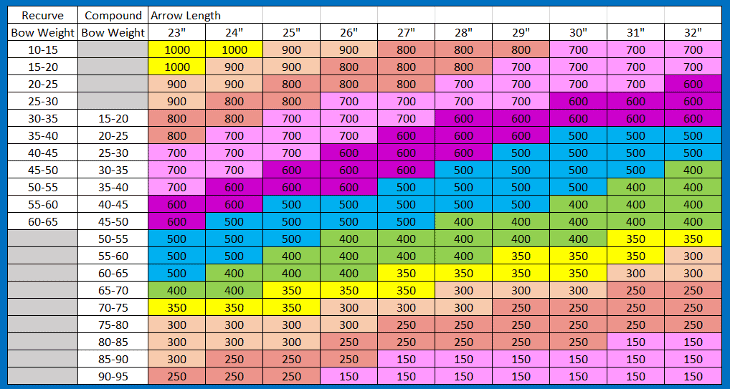
Let’s say you’re using a recurve bow with a 42-pound draw weight, and you need 30-inch arrows. You’d look at the chart, go the column on the left-hand side that says “Recurve,” trace your finger down to the box that says “40-45” (because your bow is between 40 and 45 pounds) and then put your other finger on the top where it says “30” (because you were looking for 30-inch arrows) and then bring your fingers together, where they will meet on “500.” You then know that the proper spine for your arrows will be 500, and you can browse through the site, and any arrows that have a spine of 500 should be a good fit for your bow.
Sadly, it’s not always this easy—some arrow charts get really, really complicated, and some arrow manufacturers don’t even have them online. Some have an online tool you can use, where you enter your bow type, bow weight, draw length, and so on, and the tool returns a list of arrows you can use. Sadly, most companies don’t have this. Honestly, we don’t know why they don’t make it easier.
You can also…
Go to An Online Retailer
You don’t need to buy directly from an arrow manufacturer; there are tons of big-name online stores that deliver straight to your home, and very often, it’s a lot easier to buy from these online stores than it is to buy from the archery company. You can read reviews from people who’ve already purchased the arrows, and you can ask questions, as well, and find out if an arrow is the right size and type for you.
And, finally…
Go to a Pro Shop
You can always go to a pro shop or archery store and ask specific questions to a trained professional. There are a lot of pro shop workers who don’t know their head from a hole in the ground, but there are also a lot of pro shop workers who are highly trained and really know what they’re talking about. Here in Arizona, two of the best Archery Pro Shops are Arizona Archery Club and Corner Archery. Can’t hurt to go and ask questions!
Buying Guide: Tips and Considerations
Here are some “Buying Guide”-style tips that we couldn’t figure out how to add to the other sections:
- Start out with cheap arrows. Arrows are tools that won’t last forever—they get dinged up, the fletchings fall apart, they bend, and so on. When you’re new to archery, there’s no reason to break the bank. Buy cheap at first and then buy expensive ones once you get good.
- Some arrows have vanes that aren’t glued on straight—they taper left or taper right. That’s actually not a mistake—that’s what’s called a “helical configuration.” As the arrow travels, the air pushes on the slanted vanes, causing the arrow spin, and that spin stabilizes the arrow and makes it more accurate. Pretty cool!
- There are arrows that come “shaft only,” and the archer needs to add the point, the nock, and the vanes, and there are arrows that come with points installed, with nocks installed, and with vanes installed. You’ll have a choice which you want to buy—that “shaft only” variety or the pre-made ones. If you’re a beginner, the pre-made arrows are fantastic.
- We mentioned earlier that vanes come in feathers or in plastic. Each type has its pros and cons, and here they are: feathers are great for indoor target archery and go great with recurve bows, especially if you’re “shooting off the shelf,” because the feathers won’t mess up the flight of the arrow if they touch the bow handle, because they gracefully flatten upon contact with the bow handle (whereas plastic vanes WILL mess up the flight of the arrow if they touch the bow handle, because a plastic vane won’t gracefully flatten). The bad news is, feathers get wet and weigh down the arrow, which makes them not great for outdoor archery or hunting. Plastic vanes, on the other hand, are great for outdoor archery and hunting.
- Larger and/or heavier arrows usually require larger vanes. If the vanes are too small, they won’t stabilize the arrow as it flies through the air. If you’re putting a very heavy tip on your arrow (like a broadhead), make sure your vanes are big enough. That’ll come with experience.
Some Arrow-Selecting Tips for Hunters
There are a LOT of arrows for hunters to choose from, and the longer we’re in archery, the more we realize that it’s the hunters who truly keep the archery industry afloat. There are a lot of happy target archers out there, but there are a LOT of happy hunters out there.
So, here are some tips if you’re looking to get into hunting.
- There’s no PERFECT hunting arrow (although the arrow manufacturers will try to convince you that this season’s arrows are THE BEST YOU’VE EVER SEEN!!). There just simply isn’t a perfect hunting arrow. A thinner, lighter arrow is going to whizz through the air like a bullet and be incredibly accurate, but it’s not going to penetrate game like a denser arrow would. It’s a series of trade-offs, and you’ll have to eventually figure out what works for you.
- Carbon arrows offer a lot of advantages to hunters, but carbon arrows DO break, and when they break, they’re prone to shatter. If you hunt, you need to check your arrows after you pull them out of any game you’ve shot. If the arrow is shattered, the shards from that arrow could be in the meat of the animal you’ve hunted. That’s obviously very dangerous.
- The weight of your point is going to affect your arrow flight. As we mentioned above, a heavy arrow point on a weak arrow is going to cause that arrow to wiggle like a snake, so look at the arrow chart when selecting arrow points, and then experiment and see what works.
- Most hunters use high-poundage compound bows. Remember that, in general, you’ll need a stiffer arrow as the draw weight of your bow increases. You’ll also need a stiffer arrow as the length of your arrow increases.
- Remember to take wind into account when you’re selecting hunting arrows. Wind doesn’t affect smaller arrows as much as it does bigger arrows, and that’s another reason why a lot of hunters prefer carbon arrows and/or carbon/aluminum hybrids over straight-up aluminum arrows.
- Take the time and tune your arrows right to ensure a safe and humane kill. It may sound a little preachy, but that’s fine, and it’s important to mention.
Arrow We Like
We’ve published a lot of different posts where we give in-depth reviews of arrows, but here’s a quick rundown of our favorites.
Arrows We Like for Bowhunting:
- LAUNCHPAD PRECISION NOCK - Launchpad Precision Nocks come standard on all Maxima RED arrows and shafts to deliver a controlled arrow release, better shaft alignment and more consistent accuracy shot after shot.
- DYNAMIC SPINE CONTROL - Patented hi-tech carbon material construction that manages Dynamic Spine in a new way to make broadheads fly better. Maxima RED uses different carbon materials to control arrow flex to the RED ZONE.
- REAL STRAIGHTNESS - Laser checked for straightness to a remarkable 1/10,000 of an inch; Straightness of +/- 0.0025-inches is a maximum measurement, not an average
Our top pick overall are the Carbon Express Maxima RED Carbon Arrows. They’re offered in a range of spines for bows with draw weights from 40 pounds all the way up to 92 pounds (which is not too common—that’s pretty darn heavy), and they’re designed for use with a range of broadheads. They’ve got a straightness measurement of +/- 0.0025 inches, which is excellent, and the Launchpad Precision Nocks are a nice touch—nocks are an oft-overlooked aspect of arrow performance, and we’re happy to see Carbon Express integrate some tech on their nocks.
If you’re looking for a “best bang for your buck” option, we like the PANDARUS 30″ Carbon Arrows. They’re pure carbon, feature 3-inch vanes, and are manufactured in a range of spines with a straightness of +/- 0.0006 inches—not amazing, but not too shabby, either.
- MATERIAL: Pure carbon, high quality arrowhead, special glue of 3M company , 85 Grains Screw on Field Points with Aluminum Insert(Changeable) , surface pattern processing.
- Arrow Length:30-inch/32-inch; ID: 6.2mm; Vanes: 3" TPU ; Spine 250/300/350/400/500;Straightness: +/-0.006"
- USED: For Compound & Recurve Bow (25-74 LBS), fit for hunting & target practice & outdoor shooting.
Arrows We Like for Target Shooting:
- Durable and economical
- Made from 7075 alloy
- Only arrow approved for nasp competition
Our all-time favorite arrow for target shooting is the Easton Genesis V2 Arrow. They’re designed for sturdiness—great for target shooting, and really great for longer practice sessions—and they’ve got a straightness measurement of +-.005 inches. That’s pretty good for session arrows, and they’re also great for younger archers—the only arrow that the NASP (the National Archery in Schools Program) allows at competitions. Easton makes a lot—a lot a lot—of archery products, and we’ve used a lot of it over the years, and we’ve almost always been pleased with their products.
There are fancier arrows out there—and we’ve discussed those in other posts—but these are our go-to target arrows.
If You Find All This Confusing…
…That’s because it’s wildly confusing. Honestly, it really is. It takes a little while to figure all this out, but eventually—honestly, we promise—eventually it’ll all start to make sense.
Listen: you can go pretty deep with arrows, and it takes a while to fully understand all the nuances of how to choose the *perfect* arrow for your bow. If you go on any forum, you’ll usually see that there are a crazy number of questions related to arrows—and that’s because learning all the attributes of an arrow, all the different situations in which you’ll use an arrow (in wind, at a target 15/20/25/50/70 yards away), the measurement systems, etc.—takes a LONG time. If you’ve come away from this post and you have developed only a small inkling of how to choose an arrow, we’ve done a great job!
Alright, that’s it from us. Good luck, have fun, and happy shooting!
Photo Credit: “Noodle,” Ashleigh290





